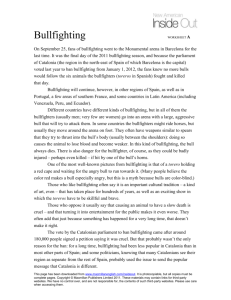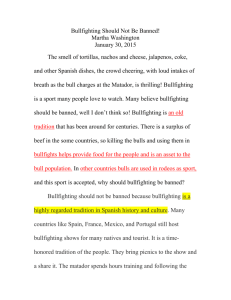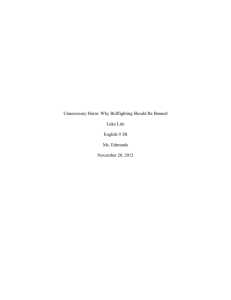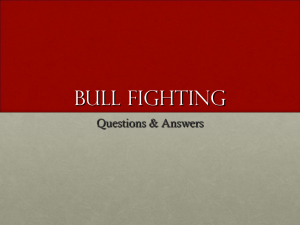A4 D4 Bullfighting
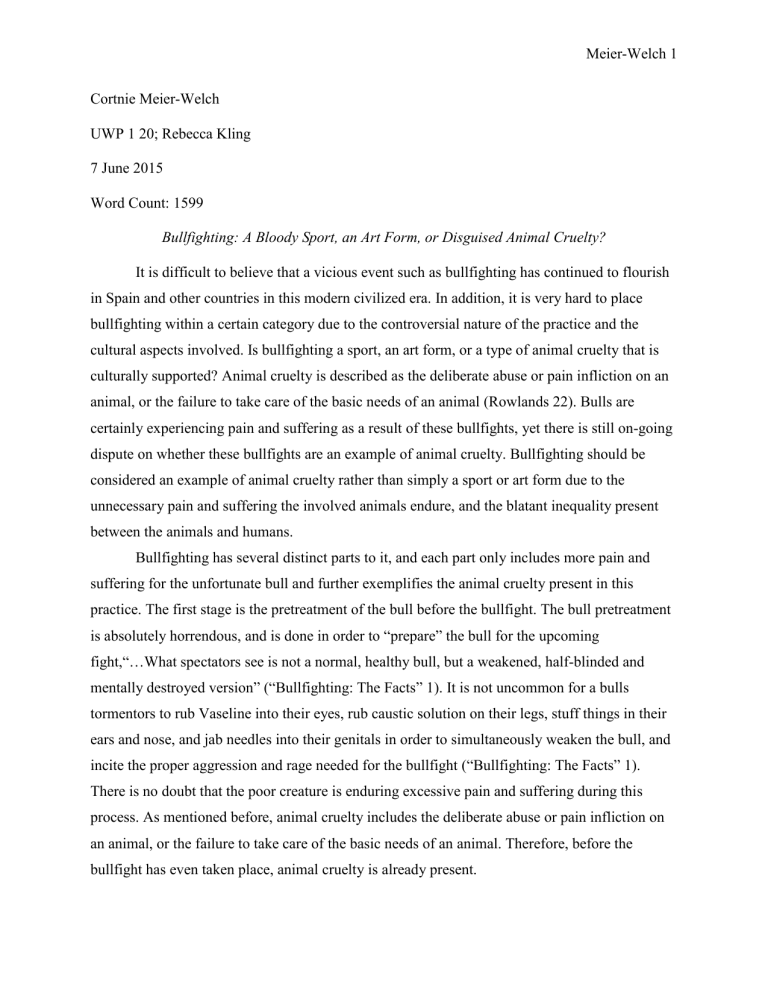
Meier-Welch 1
Cortnie Meier-Welch
UWP 1 20; Rebecca Kling
7 June 2015
Word Count: 1599
Bullfighting: A Bloody Sport, an Art Form, or Disguised Animal Cruelty?
It is difficult to believe that a vicious event such as bullfighting has continued to flourish in Spain and other countries in this modern civilized era. In addition, it is very hard to place bullfighting within a certain category due to the controversial nature of the practice and the cultural aspects involved. Is bullfighting a sport, an art form, or a type of animal cruelty that is culturally supported? Animal cruelty is described as the deliberate abuse or pain infliction on an animal, or the failure to take care of the basic needs of an animal (Rowlands 22). Bulls are certainly experiencing pain and suffering as a result of these bullfights, yet there is still on-going dispute on whether these bullfights are an example of animal cruelty. Bullfighting should be considered an example of animal cruelty rather than simply a sport or art form due to the unnecessary pain and suffering the involved animals endure, and the blatant inequality present between the animals and humans.
Bullfighting has several distinct parts to it, and each part only includes more pain and suffering for the unfortunate bull and further exemplifies the animal cruelty present in this practice. The first stage is the pretreatment of the bull before the bullfight. The bull pretreatment is absolutely horrendous, and is done in order to “prepare” the bull for the upcoming fight,“…What spectators see is not a normal, healthy bull, but a weakened, half-blinded and mentally destroyed version” (“Bullfighting: The Facts” 1). It is not uncommon for a bulls tormentors to rub Vaseline into their eyes, rub caustic solution on their legs, stuff things in their ears and nose, and jab needles into their genitals in order to simultaneously weaken the bull, and incite the proper aggression and rage needed for the bullfight (“Bullfighting: The Facts” 1).
There is no doubt that the poor creature is enduring excessive pain and suffering during this process. As mentioned before, animal cruelty includes the deliberate abuse or pain infliction on an animal, or the failure to take care of the basic needs of an animal. Therefore, before the bullfight has even taken place, animal cruelty is already present.
Meier-Welch 2
The next stage is the actual bullfight in which the bull is pitted against humans and occasionally, humans on horses. There are many different styles of bullfighting, but the traditional form of bullfighting includes three stages with picadors, assistant matadors, and the matador (Fiske-Harrison 2). In the first stage of the fight, the bull faces off with picadors; who ride horseback in order to outrun the enraged and confused bull. Their jobs are to stab the bull in the back and neck, causing it to bleed out and become exhausted. When their job has been efficiently completed, the assistant managers arrive and use harpoon-like weapons called banderillas (“Bullfighting: The Facts” 2). The banderillas are several feet long, and are plunged and buried into the bull’s flesh (“Bullfighting: The Facts” 2). This further pains and weakens the bull. Lastly comes the matador, who is supposed to kill the bull with a quick stab to the heart or artery. The matador does not always end the bull’s life quickly, which further prolongs its misery. In addition, all the bullfighting professionals are very much aware of the importance of entertainment during the fight, and they may prolong the fight – and by extension, the misery of the bull – in order to keep the audience entertained (Fiske-Harrison 3). The bull is again, experiencing intense pain and suffering during this stage, which are both characteristics of animal cruelty.
The last stage is the aftermath after a fight, and applies mainly if the particular location bans the public killing of the bull. The bull’s fate is to be slaughtered, but it does not always get killed immediately after a fight. This means the grievously injured and terrified animal is left in a dark corner bleeding without any medical attention for hours, sometimes days (“Bullfighting:
The Facts” 3). Some countries claim they have more humane ways of killing their bulls after a bullfight because they ask veterinarians to euthanize it. However, it is not uncommon for these veterinarians to arrive hours or days later when the bull has already bled to death (“Bullfighting:
The Facts” 3). Due to human neglect and abuse, thousands of bulls die each year (Keeley 2). The definition of animal cruelty includes human neglect of the basic needs and rights of an animal, which are obviously being ignored after the bullfight event.
The current dispute between whether bullfighting is animal cruelty, a sport, or both depends largely on the cultural views and the moral background of the individuals involved, and how they choose to define sport. The conventional definition of a sport is an activity involving physical exertion and skill in which an individual or team competes against another or others for entertainment (“Definition of Sport” 1). This is a working Aristoleon definition of sport,
Meier-Welch 3 however, there are other elements that must be included in an activity in order for it to meet the sufficient criteria of a sport. For example, for an activity to be supported as a sport, it “should not be judged to pose an undue risk to the health and safety of its athletes or participants… The sport proposed should be in no way harmful to any living creature” (“Definition of Sport” 2).
Bullfighting obviously breaks this as there is plenty of undue risk and harm that occurs between the participants. This is why bullfighting falls more into the category of animal cruelty, because of the harm inflicted on the bulls. In addition, a degree of equality between participants in a sport is very important. This is why players are always divided into different leagues or divisions based on age and skill level; so that a young player just learning the sport does not have to compete against an older, experienced player. This brings up the question of whether a bull and humans can ever compete on equal terms, considering how they are of different species. Even if it was determined that humans and bulls – two completely different species – could compete on sufficiently equal terms, the abusive treatment of the bull before the event should not be disregarded. As mentioned before, the bulls endure a painful pretreatment in order to weaken and enrage them. Imagine the outrage that would ensue if there was, for example, a football game where one team drugged and abused the other team before the game in order to win. Why is it any different when a bull is involved? The Spanish, and other countries, believe this to be a sport because they believe that such an inequality between participants and the inclusion of risk and harm to not be the grounds in which to condemn an activity as not a sport. Conversely, the number of locations that continue to have bullfighting are becoming increasingly fewer as time passes as it become recognized more as animal cruelty and less of a sport. Bullfighting should not be considered a sport because of the blatant inequality between the participants and the undue risk and harm that is inflicted on living participants.
After determining that bullfighting is not a true sport, the next question is whether bullfighting is an art form or purely animal cruelty. Ernest Hemingway once described bullfighting as, “Bullfighting is the only art in which the artist is in danger of death and in which the degree of brilliance in the performance is left to the fighter's honor” (Hemingway 412).
Hemingway, as many others, strongly believe in the idea that bullfighting is an art form unique to the Spanish culture. The conventional and simplistic definition of an art form is “an established from of artistic composition… requires imaginative or creative self-expression
(Adajian 1). This definition of an art form is extremely broad, and this means there are many
Meier-Welch 4 things that can fall into this category. When people first think of art, most immediately think of paintings or works that are done on paper. However, art is not constricted to the boundaries of the paper. Dance and fashion can also be considered an art form. Based on this knowledge, bullfighting can definitely be considered an art form. There is considerable forethought in the aesthetics of the whole event, which is important criteria for anything to be considered an art form. Take the matadors for example. Everything, from the way they dress and the way they interact with the bull, is done in a way to be as visually appealing to the audience as possible. Art is all about expression and the aesthetics, which bullfighting definitely includes. Bullfighting also include animal abuse and neglect, and this makes its also animal cruelty. Therefore, this is a bloody and dangerous type of art that promotes animal cruelty, but an art form nonetheless.
There is animal cruelty present within bullfighting due to the intense pain, prolonged suffering, and neglect present within the event. While some may argue that this is all an unfortunate but necessary part of the event, it does not entirely explain the need for the bull to experience abuse before and after being in the actual arena. This practice should not be considered a sport because of the inequality between the human participants and the bull, and the inclusion of undue risk and harm to living creatures. Bullfighting can be considered a bloody art form based on the loose and broad definition of an art form, but it is definitely an art form that includes animal cruelty. Even though bullfighting is also an art form, it should be treated as any other type of animal cruelty and banned. Many places have already changed the rules or banned the practice, and the hope is that other locations will adopt this practice and help make the world a better and more humane place. In conclusion, bullfighting meets the sufficient criteria to be animal cruelty and should be treated as thus.
Meier-Welch 5
Works Cited
Adajian, Thomas, “The Definition of Art,” The Standford Encyclopedia of Philosophy . Winter
2012. < http://plato.stanford.edu/entries/art-definition/>
“Bullfighting: The Facts.”
Anti-Bullfighting Committee. Web. 18 May 2015.
<http://www.stopbullfighing.org>
“Definition of Sport.”
Sport Accord – International Federations Union. 2015.
<http://www.sportaccord.org>
Fiske-Harrison, Alexander. “To the Spanish Bullfighting is Much More than a Sport.” The
Telegraph. 25 Nov. 2011. Web. <http://www.telegraph.co.uk/culture/books/8916880/To- the-Spanish-bullfighting-is-much-more-than-a-sport.htm>
Hemingway, Ernest. Death in the Afternoon.
New York City: Charles Scribner Sons, 1932. Print.
Keeley, Graham. “EU Subsidies Unregulated Village Bullfights.” The Times . 4 June 2015. Web.
<http://www.thetimes.co.uk/tto/news/world/europe/article4459510.ece>
Rowlands, Mark. Animal Rights . London: Hodder & Stoughton, 2013. Print.
